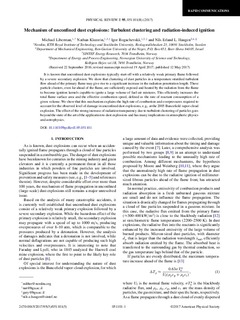| dc.contributor.author | Liberman, Michael A. | |
| dc.contributor.author | Kleeorin, Nathan | |
| dc.contributor.author | Rogachevskii, Igor | |
| dc.contributor.author | Haugen, Nils Erland L | |
| dc.date.accessioned | 2017-11-21T15:56:24Z | |
| dc.date.available | 2017-11-21T15:56:24Z | |
| dc.date.created | 2017-09-05T15:26:38Z | |
| dc.date.issued | 2017 | |
| dc.identifier.issn | 2470-0045 | |
| dc.identifier.uri | http://hdl.handle.net/11250/2467418 | |
| dc.description.abstract | It is known that unconfined dust explosions typically start off with a relatively weak primary flame followed by a severe secondary explosion. We show that clustering of dust particles in a temperature stratified turbulent flow ahead of the primary flame may give rise to a significant increase in the radiation penetration length. These particle clusters, even far ahead of the flame, are sufficiently exposed and heated by the radiation from the flame to become ignition kernels capable to ignite a large volume of fuel-air mixtures. This efficiently increases the total flame surface area and the effective combustion speed, defined as the rate of reactant consumption of a given volume. We show that this mechanism explains the high rate of combustion and overpressures required to account for the observed level of damage in unconfined dust explosions, e.g., at the 2005 Buncefield vapor-cloud explosion. The effect of the strong increase of radiation transparency due to turbulent clustering of particles goes beyond the state of the art of the application to dust explosions and has many implications in atmospheric physics and astrophysics. ©2017 American Physical Society | nb_NO |
| dc.language.iso | eng | nb_NO |
| dc.publisher | American Physical Society | nb_NO |
| dc.title | Mechanism of unconfined dust explosions: Turbulent clustering and radiation-induced ignition | nb_NO |
| dc.type | Journal article | nb_NO |
| dc.type | Peer reviewed | nb_NO |
| dc.description.version | publishedVersion | nb_NO |
| dc.source.volume | 95 | nb_NO |
| dc.source.journal | Physical review. E | nb_NO |
| dc.identifier.doi | 10.1103/PhysRevE.95.051101 | |
| dc.identifier.cristin | 1491164 | |
| dc.relation.project | Norges forskningsråd: 231444 | nb_NO |
| dc.description.localcode | © 2017 American Physical Society | nb_NO |
| cristin.unitcode | 194,64,25,0 | |
| cristin.unitname | Institutt for energi- og prosessteknikk | |
| cristin.ispublished | true | |
| cristin.fulltext | original | |
| cristin.qualitycode | 1 | |
